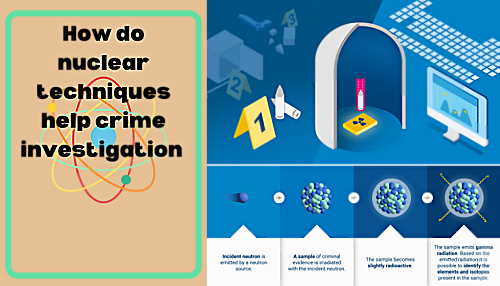Umar Rahman, Haqiquat News, India: Nuclear techniques can be used to analyse samples of forensic evidence related to crimes, from drug trafficking to murders or art forgeries. X-ray techniques, neutron activation analysis, ion beam analysis, and radiocarbon dating are among the most common methods, which can complement more traditional methods in forensic investigations. Through the analysis of the chemical and physical properties of materials, supported by other forensic evidence, such as DNA or fingerprints, these techniques can help link samples of evidence taken at crime scenes to perpetrators. Nuclear techniques can help specialists analyse microscopic traces of incriminating evidence samples, such as elements in paint or a single hair. This can help uncover information that could not be discovered otherwise, for example, the true age of forged art pieces or whether an individual was poisoned. Moreover, nuclear techniques are considerably less destructive compared to other methods, such as the use of chemicals for analysis, which can alter the original condition of fragile evidence, for example, a tiny shred of glass. Therefore, after being analysed with nuclear techniques, fragile evidence can still be preserved for further analysis.
Neutron activation analysis
Neutron activation analysis is a technique that uses the interaction between a flux of neutrons and the material being studied to determine the “elemental fingerprint” of a sample—in other words, the exact isotopic composition that provides information about its age and origin. During NAA, when samples are bombarded with neutrons, their atoms release particles and/or radiation, which can be picked up and analysed by a specialized detector. This can help determine what the sample is made of, how old it is, and where it came from. NAA is usually used to analyse the material composition of bullets in order to trace their origin, using very small samples. In addition, analysis using this technique can reveal the elemental composition of hair, which may help to uncover new details about a case—for example, the presence of drugs or other toxic substances in the body. NAA can also be used to establish the origin of premium foods and identify counterfeit products, for example, truffles, by irradiating them with neutrons and detecting the gamma radiation emitted by the atomic nuclei of the chemical elements in a small sample of the truffle. When this radiation is detected, it can help to match the elements in the sample to a particular location. It can also be used to determine the authenticity of other premium food products.
Ion beam analysis (IBA)
Ion beam analysis (IBA) is another nuclear method gaining ground in criminal investigations. For this kind of analysis, ion beam accelerators are used to speed up ions or electrons, producing a beam of charged particles. When samples of forensic evidence are placed into the ion beam, they emit radiation that can be picked up and analysed. Using ions enables investigators to understand the composition and origin of the sample, which can help to analyse drugs, explosive and gunshot residues, and fake historical artefacts. Determining the age and composition of samples means they can be more effectively used as evidence in investigations. Gunshot residues, for example, can help to investigate violent crimes involving firearms. Gunshot residue is a cloud of vapours and particles released from the explosion of a cartridge in a firearm. Nuclear techniques, such as ion beam analysis, help to detect the inorganic components originating from the shot and detect tiny particles on items related to the shooting (e.g., on the suspect’s hands or clothes) in order to confirm the identity of the shooter. IBA enables investigators to conduct elemental mapping, which helps in the analysis of specific parts of the evidence and detects tiny traces of incriminating substances, such as microscopic particles of residue on particularly small parts of clothing. Ion beams have also been used to analyse glass shards from hit-and-run accidents, which could prove useful in investigations of crimes involving vehicles. Studies show that, through a combination of IBA and machine learning, glass fragments from car windows can be traced back to various car models and manufacturers with up to 80 percent accuracy.
Radiocarbon Dating in Forensics
Radiocarbon dating is a method that uses an isotope of carbon—carbon-14—to determine the true age of ancient objects, made of organic materials and detect forgeries of art pieces. This technique can determine the age of objects up to 50 000 years old and has already helped a number of investigations to determine the authenticity of paintings, statues, and other valuable historical objects.
For example, in 2019, experts used radiocarbon dating to identify forgeries of two well-known paintings—one Impressionist and one Pointillist. Analysis of the canvas fibres revealed that they were manufactured after the deaths of the purported artists, which helped to determine that the paintings were fake.
Other methods
Other common nuclear techniques can also be used in investigations, for example, stable isotope analysis for food fraud detection. Stable isotope analysis is a technique used to determine the origin and authenticity of different foods, enabling specialists to detect and prosecute individuals involved in food adulteration (e.g., selling low-quality food under premium labels for high prices). Stable isotopes can be measured with specialized equipment, which can detect the tiniest differences in the ratios of a chemical element’s light and heavy forms. Such analysis can provide evidence about a particular type of food in order to make sure it is coming from the right region and uses authentic ingredients described on the label (e.g., detecting sugar syrups added to honey).
Conclusion: Nuclear techniques have many beneficial roles in our daily lives, Apart from helping in criminal investigations, they have immense beneficial roles in our daily lives, like space exploration. Nuclear power sources are used to power spaceships in the extreme environments of deep space. Nuclear energy is used as electrical power and helps reduce greenhouse gas emissions. Medical diagnosis and treatment: Nuclear medicine uses radioisotopes to diagnose and treat various diseases, such as cancer, heart disease, and thyroid disorders. Agriculture: Nuclear techniques can help improve crop production, pest control, food preservation, soil fertility, and animal health. These are just some of the examples of how the atom benefits life. Nuclear technologies are also used to measure pollution levels, sterilize and disinfect components, monitor and optimize industrial processes, and produce novel materials. The IAEA supports the use of nuclear technologies by providing training, equipment, and expertise to its member states.
Reference : # IAEA (International atomic energy agency)
# IAEA Office of Public Information and Communication (Received in our official mail)
# The IAEA contributes to the development and application of novel nuclear techniques for analytical purposes. The agency develops and delivers innovative nuclear analytical tools and related frameworks to support the needs of different countries


















Add Comment